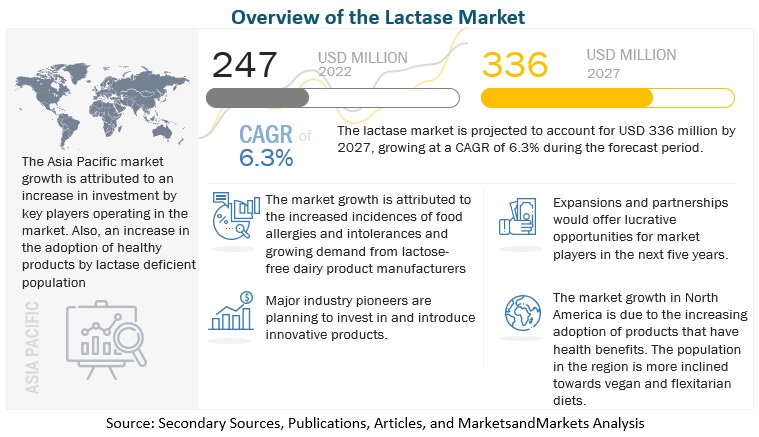According to MarketsandMarkets “Lactase Market by Source (Yeast, Fungi, Bacteria), Form (Liquid, Dry), Application (Food & Beverage, Pharmaceutical Products & Dietary Supplements), Region (North America, Europe, APAC, South America, RoW) – Global Forecast to 2025″, the global lactase market size is estimated to be valued at USD 217 million in 2020 and is projected to reach USD 298 million by 2025, recording a CAGR of 6.5%, in terms of value. The growing awareness among lactose intolerant population regarding self-diagnosis all across the globe offers potential growth for lactase enzyme, that helps in the production of lactose-free products.

Report Objectives:
- Determining and projecting the size of the global market, with respect to source, form, application, and regional markets, over a six -year period, ranging from 2020 to 2025
- Identifying the attractive opportunities in the market by determining the largest and fastest-growing segments across regions
- Providing detailed information about the key factors influencing the growth of the market (drivers, restraints, opportunities, and industry-specific challenges)
- Analyzing the micromarkets, with respect to individual growth trends, prospects, and their contribution to the total market
- Analyzing and projecting pessimistic, realistic, and optimistic COVID-19 impact on the market, with respect to source, form, application, and regional markets for 2020 and 2021.
- Identifying and profiling the key players in the global market
Download PDF Brochure:
https://www.marketsandmarkets.com/pdfdownloadNew.asp?id=125332780
Drivers: Rising cases of lactose-intolerance and growing demand from lactose-free dairy product manufacturers
Lactase enzyme find its major applications in the food & beverage industry, majorly for dairy products, as it reduces the lactose content and makes the products lactose-free. The rise in lactose intolerant population globally is one of the major factors driving the growth of lactase market, which is used in the production of lactose-free dairy products.
The demand for lactose-free dairy food products is driven by the increase in incidences of food allergies and intolerances. According to the National Center for Biotechnology Information (NCBI), nearly 65% of the global population is prone to lactase deficiency. Thus, this has led to an increase in the production of lactose-free dairy products, which helps the lactose-intolerant population to avoid gastrointestinal problems. People with lactose intolerance are unable to digest lactose present in the milk due to the lack of an enzyme called lactase, which naturally occurs in the intestinal tract of children and adults. It causes bloating and diarrhoea after consuming any dairy product, especially milk. Lactase converts the milk sugar found in dairy products, such as milk, ice cream, and cheese, to readily digestible sugars, such as glucose and galactose. Without adequate lactase, the lactose in food ferments in the intestine produces undesirable side effects. In addition, the increase in health awareness and wellness concerns among consumers is a key factor that is projected to drive the growth and demand for lactose-free dairy products.
Challenges: High processing cost and lack of technical expertise for lactase extraction
Small & medium-sized enterprises have efficient cost management due to limited capital and resources. Many quality and productivity improvement techniques are generally not finding a place in SMEs (small-and medium-sized enterprises) due to the lack of knowledge and resources to implement the same. However, the high costs involved in adapting to new technologies, production, and extraction procedures have restricted SMEs from improving their operations. Moreover, the process of lactase extraction requires technical expertise and abundant knowledge, which is majorly not present with the SMEs. Thus, extraction of lactase enzymes with fully equipped knowledge and expertise is among the major challenges for the lactase enzyme market.
Lactase enzyme modification technologies such as encapsulation of enzymes can be used to increase the shelf-life of enzymes. However, encapsulation of lactase has been considered an alternate strategy to overcome lactose intolerance and negative sensory properties of lactose-free milk. In addition, this technique is easily transferrable to other manufacturing sites and does not need sophisticated equipment. Enzyme encapsulation processes help in preserving native enzyme structures and activities. Furthermore, it can provide efficient protection against enzymatic degradation. Perhaps, the technical skills required for the encapsulation process is possessed by very less number of people. Therefore, the lack of skills among workforce is the major challenge for the lactase extraction process.
Make an Inquiry:
https://www.marketsandmarkets.com/Enquiry_Before_BuyingNew.asp?id=125332780
The North America region dominated the lactase market with the largest share in 2019, whereas Asia-Pacific is expected to witness the highest growth rate.
The lactase market in North America is dominant due to the growing demand for different types of lactose-free products such as drinkable yogurt, ice-cream, and flavored milk. Increasing awareness about lactose intolerance among consumers and growing inclination towards health promoting dietary supplements are the key factors that are projected to drive the growth of the market in the North American region.
The fastest growing market is Asia-Pacific for lactase. The increase in awareness and self-diagnosis among lactose intolerant population, also growing consumption of lactose-free products offers potential growth for the lactase manufactures in the region. The increase in health concerns and the growing trend of opting for reduced added sugar/no added sugar claims have created growth opportunities for lactase in the region. Major players such as Valio Ltd. (Finland), expanded its production facility in China to cater lactose-free products for lactose intolerant population.
This report includes a study on the marketing and development strategies, along with the product portfolios of leading companies. It consists of profiles of leading companies, such as Chr. Hansen Holdings A/S (Denmark), Kerry Group (Ireland), Koninklijke DSM N.V (the Netherlands), Novozymes (Denmark), Merck KGaA (Germany), DuPont (US), Senson (Finland), Amano Enzyme (Japan), Advanced Enzyme Technologies (India), Enmex (Mexico), Antozyme Biotech Pvt. Ltd. (US), Nature Bioscience Pvt. Ltd. (India), Aumgene Biosciences (India), Creative Enzymes (US), Biolaxi Corporation (India), Novact Corporation (US), Enzyme Bioscience (India), Infinita Biotech Private Limited (India), Rajvi Enterprise (India), and Mitushi Biopharma (India).